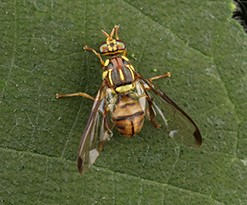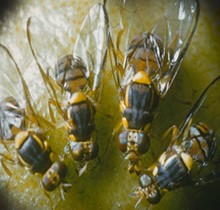California is experiencing an unusually high population of exotic fruit flies this season. The California Department of Food and Agriculture (CDFA) has issued local quarantine and eradication measures to prevent statewide spread of the Tau Fly and the Oriental Fruit Fly.
From the CDFA website,
“Exotic fruit flies are of concern to the agriculture industry in California. The larval (maggot) stage of fruit flies such as Mediterranean Fruit Fly, Mexican Fruit Fly and Oriental Fruit Fly can damage most of the fruits and vegetables grown in our state.”
CDFA and local County Agricultural Commissioners deploy and maintain over 63,000 detection traps statewide just for exotic fruit flies. High numbers of exotic fruit flies identified in traps have spurred preemptive efforts by CDFA to collaborate with USDA trapping specialists, a first for California.
Currently, there is no federal-level quarantine for the state. At the local level, active quarantine maps are available for the Tau Fly, which spans the Stevenson Ranch and Valencia areas in Los Angeles County, and the Oriental Fruit Fly, which spans the Brentwood and Santa Clara areas in Southern California.
Western Growers is following the developments of monitoring and eradication efforts of these exotic fruit flies and is awaiting further details from CDFA to report.
CDFA Pest Hotline: 1-800-491-1899
Descriptions from the CDFA:

The adult tau fly is approximately 7 mm in length (similar to that of a housefly). The body is yellow with black markings. The clear wings have two dark stripes, one along the front margin that ends in a dark spot and one about half as long running diagonal from the wing base. The female has a pointed, slender ovipositor to deposit eggs under the skin of host fruit.
https://www.cdfa.ca.gov/plant/PDEP/target_pest_disease_profiles/tau_ff_profile.html
Photo from Fan Gao via CDFA

The adult oriental fruit fly is somewhat larger than a housefly, about 8 mm in length. The body color is variable but generally bright yellow with a dark “T” shaped marking on the abdomen. The wings are clear. The female has a pointed slender ovipositor to deposit eggs under the skin of host fruit.


